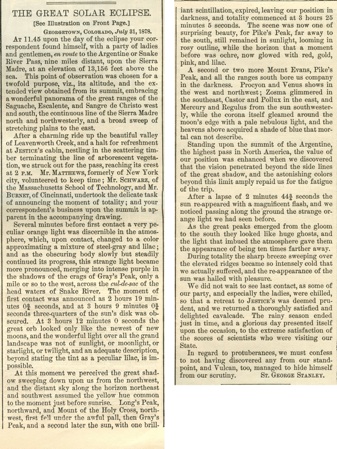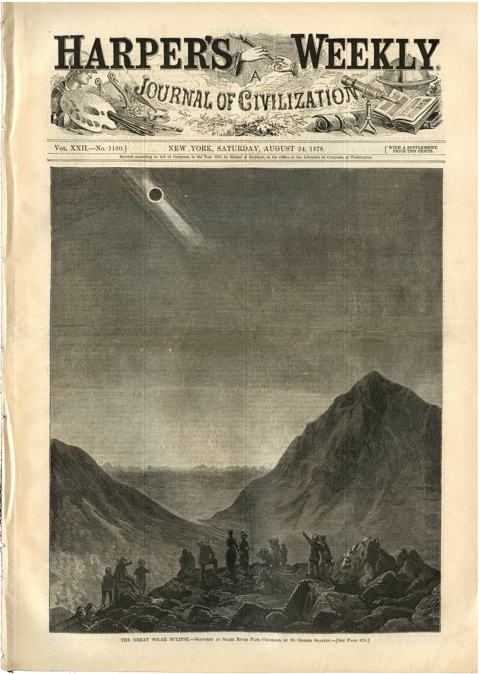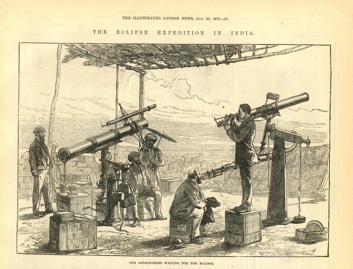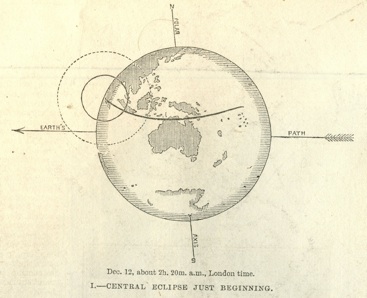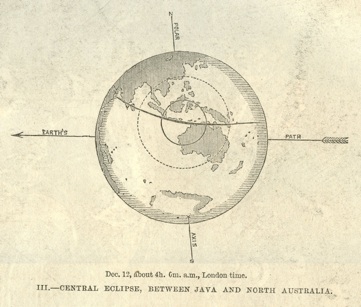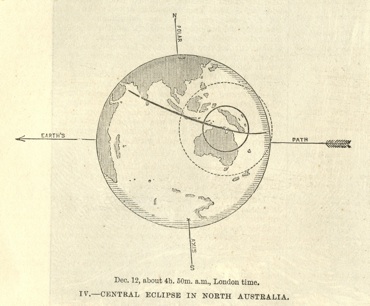Solar eclipse maps from 1871 to 1880
Indian eclipse of 1871
A British eclipse expedition was sent to observe the eclipse of December 12, 1872 in India, led by Norman Lockyer. This group was dispersed to eight locations to guarantee the successful observation of the eclipse and all were successful in observations except one. Accounts of this expedition can be read in the Illustrated London News of January 10, 1872 and January 27, 1872 and at http://www.pdavis.nl/Eclipse.htm
American eclipse of 1878
The eclipse of July 29, 1878 bisected North America from Alaska to the Gulf of Mexico. Several groups travelled to the mountainous west to observe this eclipse, including prominent Americans such as Thomas Edison, Samuel Langley, and Henry Draper.
Thomas Edison invented a device for the purpose of measuring radiation emitted from the corona. An amusing account of how chickens thwarted Edison’s eclipse observation program is at
The eclipse of 1878 was prominently featured on the cover of Harper’s Weekly of August 24, 1878. This scene shows an eclipse observation party in the vicinity of Gray’s Peak and Torrey’s Peak, in the Rocky Mountains west of Denver, Colorado.
You can read the text describing this eclipse by clicking on the news account to the left.
Sources
The maps from the British Nautical Almanac and Astronomical Ephemeris, the French Connaissance des Temps, and the American Ephemeris and Nautical Almanac were found and extracted from http://books.google.com.
The maps and illustrations from the 1878 edition of Harper’s Weekly and the 1871 issue of the Illustrated London News are from the collection of Michael Zeiler.
The page from the New York Tribune of September 29, 1875 was found at U.S. Library of Congress page on Chronicling America: Historical American Newspapers, http://chroniclingamerica.loc.gov/
Richard Anthony Proctor’s eclipse illustrations
Proctor (1837-1888) was an English astronomer best known for his ground-breaking maps of the planet Mars. He had a unique skill in popularizing astronomy and wrote many books for the public on the wonders of the sky.
For the December 9, 1871 issue of the Illustrated London News, Proctor contributed an article with a preview of the total solar eclipse of December 12. This article contained five illustrations with simple and clear diagrams of the eclipse as seen from the perspective of the sun. As Proctor noted:
-
“Figures I., II., III., IV., and V. exhibit the progress of this eclipse in a manner which I have long considered the simplest and most natural way of illustrating such phenomena. I find it difficult, indeed, to understand why this method has not hitherto been employed in our popular treatises of astronomy for illustrating not only eclipses, but the seasons and like subjects.”
These figures are indeed fine illustrations that clearly depict the geometry of a solar eclipse and explain how the earth’s rotation, tilt of the earth’s axis, and path of the umbra combine to create the curved path of an eclipse. Proctor’s work resembles that of a contemporary master of astronomical and eclipse illustrations, Guy Ottewell, author of the essential book The Under-standing of Eclipses.
You can click on the figures to view them in greater detail and also find the complete article by Proctor within the album below.

